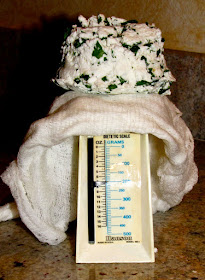Dinner for Breakfast
Some mornings just lend themselves to projects - you know, some meaningful activity either inside or outside. Other mornings, well, not so much. Today was one of the latter, a snuggle-under-the-covers kind of morning, where watching raindrops create racetracks as they slid down the windows was my favored activity. Then the raucous squawks of a lone seagull grabbed my attention as he cruised by the window on some important mission. Finally the audible squawking of my own stomach reminded me it had been a long time since dinner. Thoughts of that dinner, and the plate of leftovers in the refrigerator, nudged me out of bed. Dinner for breakfast; now that's a great start to to a day.
Friday night’s dinner was delicious, a freeform recipe creating a stacked green chili chicken enchilada plus a side salad of baby spinach, orange segments, avocado chunks and slivers of fennel. It helped to have some packets of my homemade tomatillo - poblano sauce in the freezer, fresh cilantro and roasted chicken meat in the fridge, and a new package of almonds in the pantry. Almonds were a new addition to my usual mix of ingredients, with ground almonds in the sauce and slivered almonds in the filling.
Recipe? it's the usual story; I used something from a favorite chef, another online site, or maybe even a magazine, and then tweaked it until I liked the taste.
So there I sat, pondering, how did I put together last night's version? Well, here's my typical process for building stacked or layered enchiladas.
Stacked Chicken Enchiladas
Green chili sauce:
1. Roast a dozen dehusked tomatillos, a few fresh poblano chilies, a handful of peeled garlic cloves and a quartered onion. (In a pinch, canned mild green chilies can substitute for fresh, but I don’t like the tinned flavor of canned tomatillos.)
2. Transfer the above ingredients to blender; add ½ bunch of fresh cilantro; pulse to puree the miture a bit (a few small chunks are okay).
3. Heat a bit of oil over medium-high heat in a cast iron skillet; add blender mixture. Stirring often, cook until color darkens and sauce thickens.
4. Reduce heat to low; add some chicken broth to thin; season to taste with salt and pepper, Mexican oregano and ground cumin; simmer gently. Add a small handful of ground almonds (optional). Keep warm in the skillet; as needed, use cornstarch/broth mix to thicken, or add some broth to thin.
Filling options:Shredded, cooked chicken (thigh meat is a favorite)
Strips of roasted sweet peppers
Shredded cheese (pepper-jack, swiss, Monterey jack…)
Chopped green onions
Fire-roasted corn (TJs frozen is a good choice)
Minced, seeded jalapeno chilies
Slivered almonds
Sliced green olives
Avocado chunks or slices
Fresh cilantro
Place selected filling choices in bowl; add some sauce; mix gently (or keep separate on platter if you want to change up the layers)
Building the stack:
Building the stack:
1. Preheat oven to 350.
2. Lightly oil a round pie plate (pick a size slightly larger than the tortillas you are using). Spread a thin coating of sauce on the pie plate.
3. Dip a tortilla into the skillet of warm sauce, coating both sides; place on pie plate. Top with thin layer of filling mixture; sprinkle with more cheese.
4. Repeat step 3; do it again as often as you like.
5. Top with one last sauce-dipped tortilla; press gently but firmly to even up the layers. Sprinkle with any remaining cheese and drizzle any remaining sauce over the top (don’t make it too soupy).
6. Cover with foil (tented high so it does not contact the stack). Bake for 20 minutes. Remove the foil and bake for an additional 10 minutes. Remove from oven and let rest for a few minutes; cut into wedges and serve.
Optional toppings: sour cream, salsa, cilantro, guacamole... or nothing at all.


















